

STAINED IN ONIONS
While on a working vacation in the UK I was without my fly tying materials. In my desperation I had borrowed a vice from a fellow at the University where I was working. I picked up a few hooks and some thread and gathered a few feathers. While out for a walk I came across a fair amount of wool in a paddock. It was fairly clean, so I took that home, gave it a wash, and it came out nice and white. While wondering just how many white flies I would need I noticed that there were some beets cooking for supper. wondered if I could dye some wool red? The lady we were staying with handed me a book on dying with plants, and I read about how onion skins produced a good dye. It then struck me, all those old Victorian fly dressings talking about feathers “stained in onions” was referring to the colour, not the pattern of colour.
Turns out it’s fairly easy to do. First, I washed the wool as best I could to remove the natural oils. Using white wool yarn would be far better and easier as the oils prevent the dye from being absorbed. It’s also a good idea to prepare the wool for dying by simmering it in water with some “alum” and “crème of tartar” added. lum is an aluminum salt used for pickling. I’ve not yet tried doing this, but apparently if you add too much Alum the wool becomes “sticky”. From the internet it appears about ½ teaspoon added to a cup of water, heated (not boiled) until it dissolves, then add that to two quarts (just shy of 2 litres) of water. Heat slowly and add your wool (about 2 oz of wool for this mixture) and heat slowly and simmer for an hour or so. This should make the wool more receptive to the dye, and help prevent it from washing out.
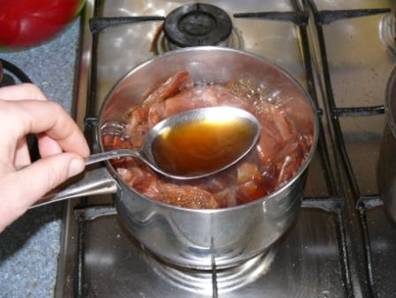
To dye
with onion skins just put the brown skins from about 8 fist size onions in
a pot. Cover with water, and gently boil for an hour and you should end up
with a yellow/brownish liquid like this:
Strain
out any solid matter and dirt, then add your prepared wool (like I said, I
didn’t prepare mine with Alum as I couldn’t find any in the UK),
and simmer for up to an hour. Some web sites suggest to pre-boil the wool
in vinegar and water (or add vinegar to the bath) to help set the colours,
which would mean vinegar is a “mordant”. However, I’ve also
heard that although vinegar may brighten the colour, it won’t “set” it
(it’s not a mordant). I have tended to pre-boil in vinegar and water,
but sometimes, and it doesn’t seem t o hurt. The final colour will be
more intense the longer you leave it in the bath, so when you are happy with
the shade, remove, rinse, and dry. The dry colour will probably be lighter
than you originally thought! Sometimes after rinsing it will be
entirely different from what you expect! That’s about it really. Here
are the results of some of my efforts with onion skins:
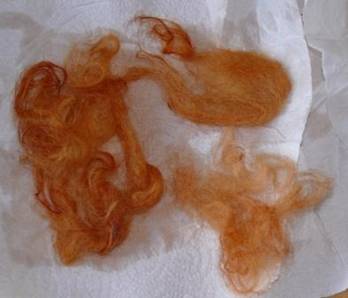
Encouraged, I tried a few other plants as well. In the picture below are the
results from all of my efforts so far.
A few things to note; some of the colours I obtained were often far more washed
out than what I would have expected based upon what they looked like in the
dye bath. For example, see the flower petal bath at the end, and the results
at number 6. They would sometimes look exceptionally intense only to rinse
off the wool rather than stain it. I think this was a result of oil still
being on the wool. Starting with white yarn might not have this problem. Also,
I didn’t have any Alum. Another curiosity is that I’ve tried dying
some mohair yarn in the water left over from boiling some beets recently.
I didn’t “prepare” the yarn by pre-boiling in vinegar and
water, nor did I add any vinegar to the dye bath (I did add some salt though).
The resulting stain was yellow, without even a hint of red as I obtained with
the sheep’s wool! Very curious.
Below are two flies I’ve tied using some of the wool. The top one has
a body dyed in dandelions, the bottom one has a body that is a mixture of
wool from batches stained in onion, coffee, and beats. So I call them
a Dandelion Bloa and a Veggie Tups.
Anyway, the process is simple, and the colours you get you can’t get elsewhere. I’ve been tying up a lot of nymphs and wet flies using this wool, and I’m very pleased with the results. I’ve even caught a few fish using the resulting flies!
Below is a photo of all the results I’ve obtained so far:
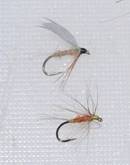
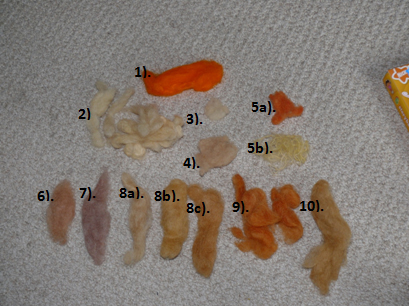
All of these are natural wool which I washed and pre-boiled in water and cider
vinegar except 5b, which was not pre-treated and is mohair yarn.
1). Saffron Powder – orange
2). Grass - blonde
3) Spinach (small amount; weak greenish tinge)
5a) beets (red with orange tinge – pretreated in vinegar)
5b) beets (yellow – not pretreated in vinegar and this is mohair yarn)
6). Red flower petals (red – much of this washed out)
7). Red cabbage (purple – again, dye bath was very intense, wool may
still have had natural oils)
8). Coffee a) a cup of coffee b) long boil of left over grinds from one days
brew c) left over grinds from a week’s worth of coffee
9). brown onion skins (burnt orange)
10). A plant in the UK growing wild in the garden; this is brown with dark
green hints to it; Surge or Scourge I think it was called.
And, finally, below is the wool dyed with red flower petals (number 6 above) while still in the dye bath. I had slowly heated the flower petals and it simmered and reduced down to what I thought was a good strong dye. After simmering the wool in it for an hour or so, I poured it out into a bowl, and let it sit for a few days (hoping it would produce a really strong colour). After rinsing under cold water though, it just washed out. Perhaps treating with Alum would have helped, and perhaps the pigments that get extracted simply aren’t taken up by the wool. What you see in 6 above is the result of two attempts to dye the same wool (the picture below is the 2nd time in the dye). Also take note of 5a and 5b, both are the results from beats! The 2nd was quite unexpected.
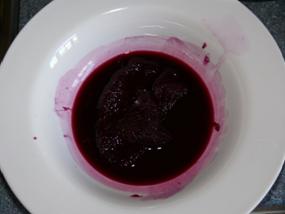
Anyway, for those of you who like to experiment, this can be quite interesting. I’ve not tried staining any feathers with plant dyes, but I know the Victorians stained partridge feathers in onions, so it can be done.
Jeff
Readers Cast Archives
[ HOME ]
[ Search ] [ Contact FAOL ] [ Media Kit ]